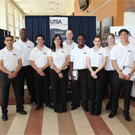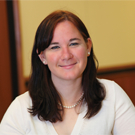News Bytes

The Art of Predicting Failure
John Foster, assistant professor in mechanical engineering, has won a grant from the Air Force Office of Scientific Research—Young Investigator Program for his project titled “Predictive simulation of material failure using peridynamics-advanced constitutive modeling, verification, and validation.”
The proposed research will seek to advance the predictive simulation capabilities for the deformation and failure of engineering materials through development, verification, and validation of new constitutive models within the framework of the peridynamic theory of solid mechanics (peridynamics). Relaxed kinematic assumptions allow the peridynamicmomentum balance to be satisfied even in the face of nondifferentiablity, discontinuities, shocks, voids and other defects in a otherwise continuous body. This allows for a straightforward and mathematically consist way to model material failure and other complex behavior. In the proposed research, new constitutive models that have no analogue in the classical theory will be explored. Starting with the unique development of beam, plate, and shell theories these models may lead to advancements that could describe material behavior not typically found in nature and therefore have implications towards advancements in macro-scale metamaterials modeling. These lower-dimensional structures will be explored in an effort for the problems to remain tractable such that analytic solutions can be developed for verification of numerical simulations. Finally, a validation effort will be undertaken to validate simulations against experiments involving material failure in the context of material uncertainty. Probabilistic techniques will be used to define convergence of computational simulations with respect to distributions of experimental data.
The total award for this project will be $360,000

First Place at Regionals was a “Steel”
Fresh from its regional first place win, the UTSA Steel Bridge Team Members are gearing up for the next round of competition. They are making improvements on their bridge design in order to place higher at the National Student Steel Bridge Competition. Not wanting to be complacent, the team realized that structural improvements can always be made, and what might win at the regional level won’t necessarily win at the state level. These modifications include everything from grinding and shaping steel to welding new parts.
The competitions consist of teams designing a bridge that meets the specifications given by American Institute of Steel Construction (AISC). Teams receive the rules in August and immediately enter the design phase. The UTSA Steel Bridge team makes certain to design all members and connections according to rule specifications giving them the best chance to win. Design and structural analysis is done using computer programs such as SAP2000. The bridge must not only be light and sturdy, but it is necessary that be assembled as quickly as possible.
Upon completion of the design phase, the team builds the bridge in the engineering machine shop located on west campus. Using all the tools available, the team welds, cuts, and grinds steel tubing to construct the bridge. After two months of designing and three months of building, the team tests the bridge’s strength and practices putting it together in a timely manner. The bridge consists of about 40 members this year with bolted connections. The bridge team is composed of 15 students who come from both the undergraduate and graduate level
The regional 1st place victory in March is the first overall win since 1997. Prior to this victory, the UTSA Steel Bridge Team has placed second overall in 2009 and 2010.

Inaugural Texas Energy Expo
The UTSA College of Engineering hosted its inaugural Texas Energy Expo, a student-run career fair, Tuesday, March 5 in the University Center Ballroom. More than 250 students and alumni spoke with the representatives of the 11 companies in attendance.
Spearheaded and organized entirely by students within the College of Engineering Student Council and the College of Business Student Council, the objective of the career fair was to connect companies operating in South Texas and the Eagle Ford Shale with some of the best and brightest science, technology, engineering, math (STEM) and business students in Texas.
“The Texas Energy Expo provided unparalleled opportunities for students to learn what employers are looking for, in both intern and entry level employee prospects. Companies that participated in the expo experienced first-hand how many highly educated and passionate student leaders we have at UTSA. Since the first expo was such a great success we are now looking into improving the expo and making it an annual event,” said Andrew Baines, master’s student in mechanical engineering.
To make the event a success and maximize participation, the students solicited sponsorship and participation from businesses in the energy sector. Travis Capp, vice president of Energy and Gases of Valero, was the keynote speaker, and he spoke about the changing landscape of the oil and gas industry.
“This was truly a learn-by-doing event and COE students were quick studies. It was important for them to develop people and management skills that they would not ordinarily learn in the classroom,” said Otis Scott, career counselor for the College of Engineering.
Training the next generation of problem solvers, UTSA is consistently producing a diverse group of highly competitive future leaders in the STEM and business fields.
The UTSA College of Business is ranked number seven and the College of Engineering number five in the nation for graduate programs serving Hispanics by Hispanic Business magazine
“UTSA has come a long way in moving toward Tier One status. We’ve grown at a tremendous rate and people are starting to take note. We can easily compete with other prestigious schools in the nation. So this expo was another way to show how exceptional our students are,” Katherine Parks, sophomore in mechanical engineering, explained.
All proceeds from the expo not used to cover fair costs went to support student organizations, multi-disciplinary senior capstone projects, and student attendance at major national STEM and business conferences.

UTSA’s Scope of Influence Goes National
Beth Pollot is well on her way to bringing the national spotlight to UTSA. A doctoral student studying biomedical engineering, Pollot recently became the president of the National Student Chapter for the Society for Biomaterials.
The purpose of the National Student Section of the Society for Biomaterials is to encourage the development, dissemination, integration, and utilization of knowledge in biomaterials among students, and encourage multi-disciplinary interactions among all members of the Society For Biomaterials.
Pollot’s duties will include organizing a national chapter meeting, hosting development luncheons, ensuring all chapters within the society are working toward the mission objectives, and to create and nurture an awareness of biomaterials in young engineers and scientists

